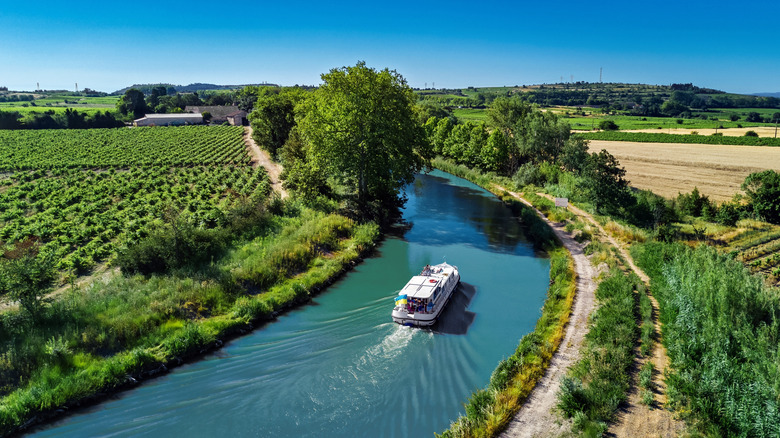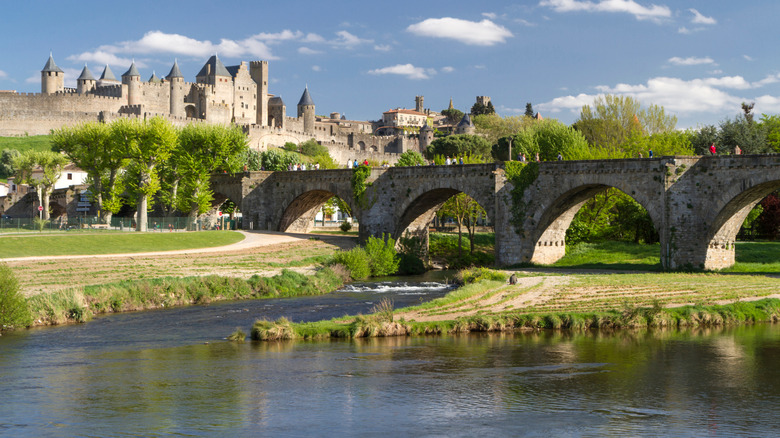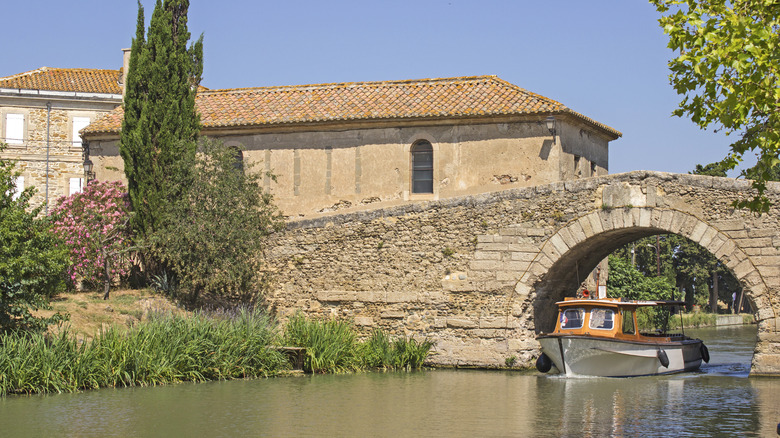This French Waterway Is A Boating Haven To Fairytale Fortresses, Charming Villages, And World-Class Vineyards
In the south of France, a 150-mile canal stretches all the way from Toulouse, the pink-hued, charming French paradise, to the Mediterranean. The Canal du Midi, as it's named, is a feat of engineering from the 17th century, built as part of a project to create a trade route connecting the Atlantic and Mediterranean across France. It's also an admirable work of aesthetic vision, carefully designed to complement the landscape with graceful stone bridges and picturesque locks. The combination of the canal's history, innovation, and beauty has solidified it as a UNESCO World Heritage Site.
Visitors of every stripe will find something to enjoy along the Canal du Midi, from wine tastings to medieval fortresses and iconic bridges. If you cruise down the canal by boat, you can opt for anything between a two-hour boat tour of a portion of the canal or a week-long journey on a hotel barge. Boat rental companies are all along the canal, and you don't need a permit to drive one yourself. You could also take your own canoe or paddleboard, but you'll need to get off and walk around locks, as smaller watercraft aren't allowed in these. The canal is lined with towpaths that make for a dreamy route for walkers and cyclists, too. You could start at any of the canal's idyllic waypoints.
Historic dishes and fortresses along Canal du Midi: Toulouse to Carcassonne
If you're flying into France, starting in Toulouse is a convenient option for visiting the Canal du Midi — Toulouse-Blagnac Airport is about 10 miles from Port Saint-Sauveur, with public transport available. As both the starting point of the canal and the capital of Occitania, Toulouse gives you a sense of the canal's and the area's history. Stop at the Canal du Midi archives building at Port Saint-Etienne, which contains all of the historical documents related to the canal, all the way back to the first flirtation with the idea of building a canal here in 1598.
Following the canal down from Toulouse to Castelnaudary is the most peaceful stretch. There isn't much to see between these checkpoints, but you do get to experience the most prominent section of plane trees, planted with exposed roots to fortify the banks. Castelnaudary is best known for the local cassoulet, a beloved pork and bean dish. Chez David is one of the most famed restaurants in Castelnaudary that specializes in the meal.
At this point, you're in the corner of France that Rick Steves says is more authentic than its crowded neighbors. The next significant stop from Castelnaudary heading south is the medieval, walled city of Carcassonne, which is punctuated by a glorious castle. The Canal du Midi passes through the Fresquel aqueduct at the point where the canal intersects with the Fresquel River — it was this aqueduct that enabled the canal to cross Carcassonne.
Vineyards and villages along Canal du Midi: Homps to Sète
If you want to savor the regional wines along the Canal du Midi, make sure to stop at the village of Homps, south of Carcassonne. Lush vineyards roll out all around the village. You can find some of the best wines of the region (known as Minervois) at the Maison des Vins du Minervois, located right along the banks of the canal, at the Port d'Homps. If you walk about 20 minutes from here, you'll get to Jouarres Lake, a lovely spot to go for a swim or relax at a lakeside surrounded by vineyards and olive trees.
From Homps, the canal passes through numerous lovely villages before reaching the coastline. One is Paraza, a pretty, medieval site with galleries and the hilltop Château de Paraza. Pierre Paul Riquet, the canal's engineer, stayed at this château while designing the canal. Further along is Le Somail, best known for its stone, humpback bridge. As you pass under it, you might notice a plaque bearing a familiar name: Thomas Jefferson. Jefferson once traveled the canal himself and stopped at Le Somail in 1787.
After traversing some more cute villages and innovative canal features (including a flight of six locks at Béziers), the canal reaches Sète, sometimes called southern France's "Venice," on the Mediterranean coast. In fact, Sète is full of canals, and the city's layout is dictated by them, with seafood restaurants and colorful terraces lining the waterways. Stop by La Criée aux Poissons, a fish market in Sète's old port, where you'll see fishermen and shoppers haggling over the daily catch. For those on bikes, the Lido greenway is a gorgeous path that goes from Sète to Marseillan, skirting dunes and beaches.


